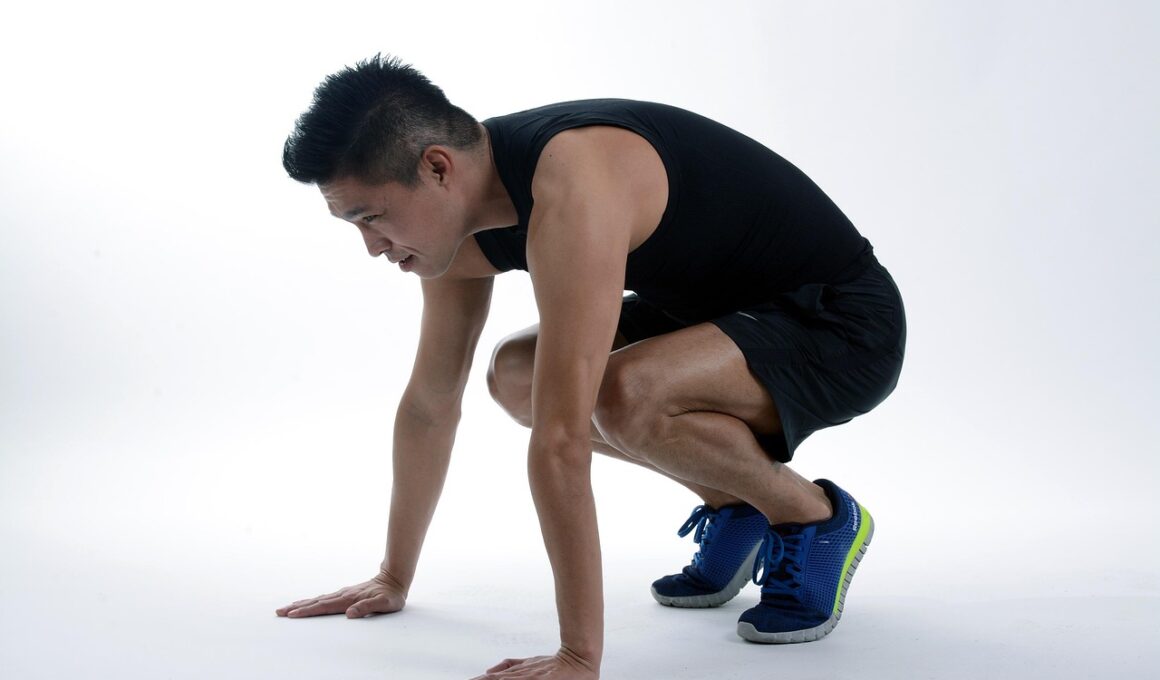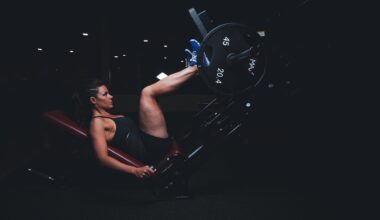Tips for Increasing Reps and Sets in Squat and Lunge Workouts
Bodyweight exercises like squats and lunges are crucial for building lower body strength. To maximize your performance, implementing progressive overload is essential. Start by monitoring current reps and sets. Gradually increase these numbers to challenge your muscles. For instance, if you can comfortably perform 10 squats, aim for 12 in your next session. You can also test your limits with variations. Consider trying single-leg squats or walking lunges. These variations not only keep the workout engaging but also activate different muscle groups. Add resistance to maximize intensity. Incorporating weights or resistance bands can enhance each movement. Moreover, establish a structured workout routine, ideally three times a week, allowing muscles to recover. Muscle recovery between workout sessions is vital for growth. You should also pay attention to your form; performing exercises correctly prevents injury and ensures effectiveness. Incorporate dynamic stretches prior to your workout to enhance your range of motion. Consistency and dedicated practice lead to overall endurance and strength. Tracking your progress will motivate you and provide valuable insights into your fitness journey. Focus on achievable goals and make adjustments accordingly.
Focus on Proper Form
Proper form is the cornerstone of effective squats and lunges. Taking the time to learn correct techniques pays off in the long run. Begin with bodyweight exercises to master your form before adding resistance. Stand with feet shoulder-width apart for squats. Keep the core engaged, and lower the body by bending your knees. It’s important that your knees don’t extend past your toes. Similarly, for lunges, step forward with one leg at a 90-degree angle. Ensure that the back knee hovers above the ground without touching it. This prevents excessive stress on your knee joints. Moreover, regular assessment of your form through mirrors or videos can be beneficial. Utilize platforms that offer feedback or suggestions on improving your stance and positioning. Breathing techniques matter too; exhale while exerting and inhale while lowering your body. Consciously reminding yourself to relax your shoulders also contributes to a more stable posture. These refinements lead to better endurance. Remember, improving your squat and lunge technique translates to enhanced performance in other exercises. Always strive for excellence.
Incorporating Variety into Your Workouts is essential for avoiding plateaus. Repeat workouts can become monotonous and decrease motivation. Employ different squat and lunge variations to engage various muscle groups. Try goblet squats or sumo squats for diversity. Similarly, lateral lunges or curtsy lunges can challenge balance and strength. Integrating balance exercises like single-leg stands can further enhance stability within your routine. If you’re looking for an additional challenge, you might explore plyometrics, like jump squats or jump lunges, which promote explosive power. Continuing to mix workouts is important even after mastering traditional forms. Schedule weekly plans with diverse exercises to maintain engagement. Additionally, setting cycling routines for workouts makes it easier to measure progress over time. This variety keeps the muscles guessing, encouraging adaptation and growth. Partner with a workout buddy online or join a community to stay inspired and accountable. Participation in group classes can also add a fun dimension to your training. Diversifying your routine offers fresh challenges, which are essential for lasting transformation. Never forget, your body responds to new stimuli, and keeping workouts exciting may prevent boredom.
The Importance of Rest and Recovery
No workout strategy is complete without emphasizing rest and recovery. Squats and lunges are demanding exercises that require recovery time for muscle growth and repair. It is crucial to allow your body sufficient time to recuperate between workout sessions. Aim for two to three days of rest between exercises targeting the same muscle groups. On these rest days, consider engaging in light activity, like walking or yoga, to maintain mobility without placing excess strain on your legs. Sleep also plays a significant role; aim for at least seven to eight hours per night to facilitate recovery processes. Additionally, proper nutrition provides fuel for recovery; incorporate protein-rich foods to help repair muscle tissue. Hydration is equally vital; water aids the performance of cellular functions during recovery. Scheduling deload weeks, where the intensity of workouts is reduced, can also be beneficial for longer-term growth. These rest strategies should not be neglected, as they contribute significantly to overall performance gains. By valuing rest, you ensure that your body is prepared for the next workout, maximizing improvement and strength over time. This balanced approach is key.
Tracking your progress throughout your squat and lunge workouts is vital in the realm of fitness. Keeping a detailed record encourages motivation while revealing areas that might need adjustment or improvement. Use fitness apps, journals, or spreadsheets to log your complete workout data, including sets, reps, and weights used. Regularly assessing this data helps you identify trends, allowing you to celebrate your successes, which fosters a greater commitment to your fitness journey. Set specific short-term goals, like incrementally increasing the number of reps. Longer-term targets can be benchmarks for improving overall fitness, like achieving a certain number of unassisted repetitions. Sharing your achievements with friends or in fitness communities can offer additional motivation and accountability. Photos and measurements can also complement progress tracking, allowing you to visualize changes in strength and endurance. Furthermore, consistency is instrumental; stick to your planned schedule and note any obstacles you face. Acknowledging these challenges permits you to adjust accordingly. Regular reflection on your progress keeps you invested and enthusiastic about evolving your capabilities over time. This positive feedback loop ultimately leads to significant advancements.
Nutrition to Support Performance
Nutrition is a critical factor in enabling effective exercise performance, especially when focusing on squats and lunges. Consuming a balanced diet that supports your energy needs is essential for optimal workouts. Ensure adequate protein intake for muscle recovery; foods such as lean meats, legumes, and dairy are great sources. Carbohydrates also play a pivotal role, as they provide the energy required for intense training sessions. Look for complex carbohydrates, including whole grains, fruits, and vegetables, to fuel your body efficiently. Healthy fats should not be overlooked either; including nuts, seeds, and avocados promotes overall health and energy balance. Additionally, mapping out pre- and post-workout meals can vastly enhance performance and recovery. Eating a light carbohydrate-rich snack like a banana approximately 30 to 60 minutes before exercising can give you a quick energy boost. Post-workout, aim for a meal or snack with both protein and carbohydrates within 30 minutes to facilitate muscle repair. Hydration promotes performance as well; drink water before, during, and after your workouts to stay hydrated. Tracking your food intake is beneficial to see how it correlates with workout progress.
Finally, embracing a growth mindset is essential in the realm of bodyweight exercises like squats and lunges. Cultivating this mindset allows you to approach challenges positively, viewing setbacks as opportunities for learning rather than obstacles. Celebrate every small achievement along the way, reinforcing the notion that improvement takes time. Instead of focusing solely on the numbers of reps and sets, appreciate the consistent effort you invest in each session. Visualize your fitness goals to keep motivation high, integrating them into your daily routine. Setting realistic expectations while pushing your limits can also enhance your experience. Engaging thoughtfully with fitness communities, whether online or in-person, fosters a support network that encourages your journey. Encouragement from others can inspire resilience during challenging times. Be open to feedback and adapt your strategies; this flexibility is a core component of growth. When obstacles arise, evaluate areas for improvement, adjusting your focus as needed. Understanding your body’s signals will further foster a deeper connection to your workouts. Ultimately, your effort in adopting this perspective will lead to significant health and fitness rewards.


